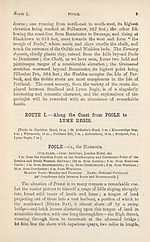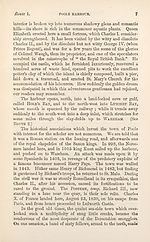Download files
Complete book:
Individual page:
Thumbnail gallery: Grid view | List view

FROM POOLE TO LYME REGIS.
Route 1.
and stud the harbour with numerous vessels ;—imagine that har¬
bour at high water, a broad sweep of rolling waves running up
into the land in a score of picturesque little creeks, but at low
water a dreary tract of mud and sand, which is only intersected
by a few deep channels; place near its mouth a large island,
Brownsea Island, and several smaller isles of little interest to
the sketcher, but of great perplexity to the mariner ; and, to the
south-west, raise a long wall of chalk surrounding and barricading
from the mainland the famous Isle of Purbeck,—and a tolerable
notion of the position of Poole may be obtained.
It has a strong sea-water flavour about it, and the streets are
usually filled with the tars of many nations, and with those para¬
sites who live by or upon them. Fishermen, too, pervade it with
strange oaths ; for off the mouth of the harbour the oyster-boats
collect after a successful haul, piling upon the shore the shells of
those crustaceans which are selected for pickling, so as to form a
curious artificial breakwater. The clink of hammer and mallet
warns us that shipbuilding is one of the trades of Poole ; and its
inhabitants are also employed, as a glance round its streets informs
us, in the manufacture of seamen’s shirts and clothing, cordage
and sailcloth, and in the purveyance of ships’ stores and provisions.
The clays for which its neighbourhood is remarkable are exported
in large quantities, while from Newfoundland and the North of
Europe are imported oil, com, salt fish, and timber. Poole is
therefore a busy and prosperous town, but not a resort for dilet¬
tante tourists or summer excursionists.
Its Harbour at low water is, as we have hinted, a complica¬
tion of sand-banks, mud-banks, and narrow channels, which only
the most experienced pilots can navigate in safety. When the
tide sweeps in with a roll and a rush, it becomes not less dan¬
gerous, perhaps, but infinitely more picturesque, and gleams and
glitters in the sunshine like a noble lake, 7 miles long and 4|
miles broad. Its circuit is not less than 35 miles, and it admits
vessels drawing 14 feet of water. The same phenomenon is
visible here as at Southampton—that of a double tide, with an
interval between of an hour or more. It is produced by the ebb
of the channel waters, which pent up the harbour-current until
the time for their own recession arrives.
At the mouth of the harbour lies Branksea (fern island), or
Brownsea (Brano’s ey) Island, 1£ mile by f mile, or 6 miles
in circumference. Its sides are clothed with groves of fir—ita
Route 1.
and stud the harbour with numerous vessels ;—imagine that har¬
bour at high water, a broad sweep of rolling waves running up
into the land in a score of picturesque little creeks, but at low
water a dreary tract of mud and sand, which is only intersected
by a few deep channels; place near its mouth a large island,
Brownsea Island, and several smaller isles of little interest to
the sketcher, but of great perplexity to the mariner ; and, to the
south-west, raise a long wall of chalk surrounding and barricading
from the mainland the famous Isle of Purbeck,—and a tolerable
notion of the position of Poole may be obtained.
It has a strong sea-water flavour about it, and the streets are
usually filled with the tars of many nations, and with those para¬
sites who live by or upon them. Fishermen, too, pervade it with
strange oaths ; for off the mouth of the harbour the oyster-boats
collect after a successful haul, piling upon the shore the shells of
those crustaceans which are selected for pickling, so as to form a
curious artificial breakwater. The clink of hammer and mallet
warns us that shipbuilding is one of the trades of Poole ; and its
inhabitants are also employed, as a glance round its streets informs
us, in the manufacture of seamen’s shirts and clothing, cordage
and sailcloth, and in the purveyance of ships’ stores and provisions.
The clays for which its neighbourhood is remarkable are exported
in large quantities, while from Newfoundland and the North of
Europe are imported oil, com, salt fish, and timber. Poole is
therefore a busy and prosperous town, but not a resort for dilet¬
tante tourists or summer excursionists.
Its Harbour at low water is, as we have hinted, a complica¬
tion of sand-banks, mud-banks, and narrow channels, which only
the most experienced pilots can navigate in safety. When the
tide sweeps in with a roll and a rush, it becomes not less dan¬
gerous, perhaps, but infinitely more picturesque, and gleams and
glitters in the sunshine like a noble lake, 7 miles long and 4|
miles broad. Its circuit is not less than 35 miles, and it admits
vessels drawing 14 feet of water. The same phenomenon is
visible here as at Southampton—that of a double tide, with an
interval between of an hour or more. It is produced by the ebb
of the channel waters, which pent up the harbour-current until
the time for their own recession arrives.
At the mouth of the harbour lies Branksea (fern island), or
Brownsea (Brano’s ey) Island, 1£ mile by f mile, or 6 miles
in circumference. Its sides are clothed with groves of fir—ita
Set display mode to:
![]() Universal Viewer |
Universal Viewer | ![]() Mirador |
Large image | Transcription
Mirador |
Large image | Transcription
| Antiquarian books of Scotland > Adventure and adventurers > Black's guide to the counties of Dorset, Devon, & Cornwall > (26) |
|---|
| Permanent URL | https://digital.nls.uk/142586690 |
|---|
| Description | Thousands of printed books from the Antiquarian Books of Scotland collection which dates from 1641 to the 1980s. The collection consists of 14,800 books which were published in Scotland or have a Scottish connection, e.g. through the author, printer or owner. Subjects covered include sport, education, diseases, adventure, occupations, Jacobites, politics and religion. Among the 29 languages represented are English, Gaelic, Italian, French, Russian and Swedish. |
|---|

